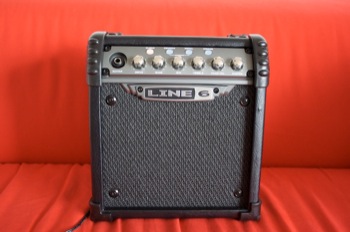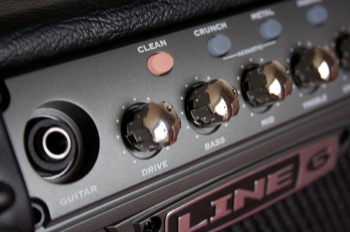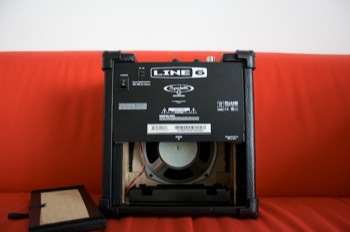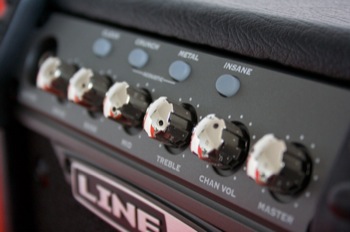Determined not to let Roland’s Micro Cube and Vox’s DA5 be the only contenders for portable-amp champ, Line 6 has entered the ring with its Micro Spider.
 |
Traveling with your electric guitar is not an easy task, especially if you have a heavy tube amp and no roadie. Of course, certain solutions like the POD exist, but you won’t be able to play your last song for your entourage unless you take turns with the headphones or plug the device into a hi-fi system. So you need a good sounding portable amp. That’s where battery powered mini-amps come in.
While Roland has been the undisputed champ with its Cube, Line 6 has completed its line of amps with the Micro Spider, a small 6 watt amp with a 6.5" speaker. In order to work, it needs either a DC adapter (included), or six C batteries. With its 5 electric guitar amp models, acoustic guitar model, six effects and built-in tuner, the Micro Spider hopes to get a piece of the portable-amp pie.
Presentation
 |
When you unpack the amp you immediately recognize Line 6’s style, with its chrome knobs on black, therefore it looks just like the other Line 6 models. Without having the charm of a Champion 600, the Micro Spider holds its own. Line 6 made the right choice in including the strap that lets you carry this light amp: 3,2 kg. But unfortunately, the way it attaches isn’t that reliable, and it would have been nice to have a « hard » handle that was well attached. The buttons that lets you change the amp models are back-lit, but seem a little too soft. As far as the knobs go, they seem to be sturdy. The amp gives off and air of quality and seems to be made for bringing it along with you wherever you go.
The only criticism here: the rear panel that gives access to the batteries is held in place by Velcro (like the Vox D5) and gives this amp a cheap and unreliable aspect. But this bad point hides a good one: this space is large enough to stuff a cable or other small accessories into it.
Let’s take a look at the Specs…
Settings and Connections
 |
As far as connections go, they’re simple: a 1/4" instrument input to plug in your favorite guitar, a 1/4" microphone input with dedicated mic trim knob, and a Mini stereo MP3/CD input. Output-wise, the Micro Spider has only one 1/4" headphone/record output which serves as a phone/line out for use with either headphones or as a record out going directly to a PA, a mixing board, or your audio interface. You should note that when you use this output, the internal speaker is cut.
For settings, there are the classic bass, mid, and treble for EQing, Drive for distortion, chan vol and master for general volume. 4 back-lit buttons let you choose one of the 5 channels/presets: clean, crunch, metal, insane and acoustic. The latter is selected by pressing crunch and metal at the same time. On top of the amp there’s a knob that lets you adjust the mic level and two other knobs that control the « Smart Control FX ». The first one activates the chorus/flanger, phaser and tremolo. The second knob controls sweep echo, tape echo and reverb. This system allows you to find a desired effect quickly but isn’t very precise. The Tap button lets you synchronize the effects to your chosen tempo. By keeping the Tap button pressed you activate the integrated chromatic tuner that has a note-name display. It also has three leds that show whether the sound is too high or too low. This system works very well and lets leave your hardware tuner behind.
So let’s see how it sounds…
The Sound
 |
So here’s the moment of truth; when you take your favorite guitar and plug it into the amp. The first surprise is positive or negative depending on your point of view: the volume is loud enough to give you neighbors something to complain about if you live in close proximity to others. Even though it’s not loud enough to play alongside drums, it will definitely fill your apartment with sound. In my apartment I never went above the half-way mark.
The test started with a SM57 in front of the amp and a Strat in hand. The clean preset (examples 1 & 2) isn’t bad, even pretty good considering the size and price of the amp. There’s plenty of volume, and the sound is fat without being too bassy. You might imagine that because it’s a small amp, the sound would be nasal, but it’s not. The guitar’s sound is relatively well preserved which is a nice surprise. The crunch channel (examples 1 & 2) is in the same vein and it was easy to get some really nice sounds out of it. Unfortunately, all praises end as soon as either the ‘Metal’ or ‘insane’ is pressed. There’s definitely a lack of low frequencies which the small 6.5" speaker just can’t dish out. There’s no miracle here, we’re dealing with a portable amp for sure, and nothing can replace a good 4 × 12. Nevertheless, if you consider the micro spider as a practice tool, then it will suffice. The last position, « acoustic », is ok for amplifying an acoustic guitar but the absence of a tweeter make the highs seem less present. This channel can come in handy but don’t expect it do justice to your acoustic… Some nice small details: it’s possible to activate a virtual boost, if needed, by keeping the TAP button pressed and turning the gain knob past the half-way mark. A noise-gate can also be activated in this manner by turning the echo/ reverb knob past the half-way mark. And last but not least, you can record your favorite settings by keeping each channel button pressed.
 |
When using headphones, you get more bass (if you use a good pair of headphones), but there’s a background noise when the distortion is high. This output (according to the manufacturer) can also function as a direct out. But it’s not really up to par with a real line out and one should be careful with volume settings to avoid clipping in your mixer or sound card.
The mic in, of course, doesn’t have phantom power and is to be used with a good old dynamic microphone such as a SM58. As far as sound goes, the Micro Spider does its job, but there’s nothing to write home about. As for the effects, the smart control FX knobs give a fairly wide variety of sounds with just these two knobs. On the other hand, those who like to tweak their sound will have gone through all the possibilities rather quickly. But that’s not what’s interesting about the Micro Spider, and it’s always nice to quickly find the effect your looking for. Sound-wise, the amp has it uses as long as you don’t push the volume or the gain too much.
Conclusion
Conclusion
The Micro Spider has successfully entered the arena of portable, battery-powered amps and will force the competition to react quickly. It has turned out to be quite complete, with its large sonic palette, integrated effects, tuner, mic in and compactness. Its clean and crunch sounds are surprising and will surely satisfy many guitarists. When you think that you get all this for a price of around 100 euros!….
The only faults that can be mentioned are due to its size, especially the absence of lows with distorted tones. Nevertheless, it would have been nice to have a better quality POD 2.0-style direct output and a less aggressive sound when gain is turned up. And even though the amp seems solid and ready to be carried around the world, the cheap strap and rear panel rain on the parade.
The Micro Spider possesses many qualities that make it an ideal companion for nomadic guitarists, and one forgets quite voluntarily its few minor faults.
[+] Clean and Crunch sounds
[+] Price
[+] Integrated Tuner
[+] Integrated Effects
[+] Mic input
[+] Size and Weight
[+] Sound Power
[-] Metal & Insane sounds
[-] Line Out Quality
[-] Battery cover/Rear panel
[-] Strap
